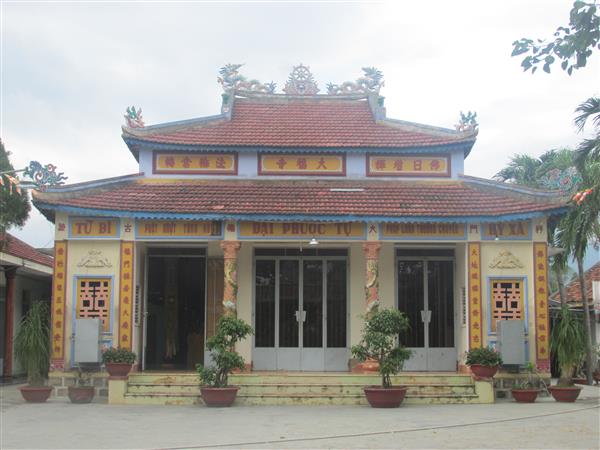Description
Dai Phuoc Pagoda is located in Dai Dien Trung 1 village, Dien Dien commune, Dien Khanh district, Khanh Hoa province.
From the second half of the seventeenth century, Vietnamese people from the central provinces (Quang Tri to Binh Dinh) migrated to the new land in Dien Khanh increasingly. In the land north of the Cai River and the villages along the Dien Khanh citadel, there were early places where rich villages of the Vietnamese people were formed. The manifestation of a stable life on the new land of agricultural residents is that after reclaiming land, establishing a village, settling down and settling down, people set up pagodas and built communal houses as places of worship.
Based on the picture hanging at the Buddhist temple of Dai Phuoc pagoda "成 泰 玖 " (transliterated: Thanh Thai nine years of five moons and days of reformation; translation: Reformed: Reformed) (on) auspicious day on May 6, 9th Thanh Thai year (1897); we can guess that Dai Phuoc Pagoda dates back to the period from the mid-19th century onwards.
Since its inception, Dai Phuoc Pagoda has undergone recent renovations in 1990 and 2001.
Dai Phuoc Pagoda worships Shakyamuni Buddha, Guan Yin Bodhisattva, Ksitigarbha Bodhisattva, Dharma Protector, Tieu Dien and Quan Thanh De Quan...
Dai Phuoc Pagoda turns to the South, with a total area of 1,910.8 m2. From the outside to the inside, the pagoda includes the following architectural works: Tam Quan, Ho Phap Temple, Tieu Dien Dai Sy Temple, Quan Am station, Tien Duong - Buddha hall, ancestral house, monk house, tru house, etc. tower tomb.

The forecourt has an architectural structure consisting of two floors, eight roofs with western tiles, on the decorative roof system embossed with two dragons flanking the wheel of Dharma; Below are rows of Vietnamese characters: In the middle is "Dai Phuoc Tu"; on the left is "Dharma wheel is always turning" and "Happy discharge"; On the right are "Buddhist Sangha" and "Compassion". The front porch has a pair of couplets written in Han Nom with the first two letters forming the pagoda's name;
Spelling:
The great-scale restoration of the ancient temple,
Blessings of the noble and generous land of sentient beings.
Translate:
Large land (Great) scale, restored ancient people,
The door of merit (Blessed) is noble, generous and generous to all sentient beings.
Connected to the front street is the Buddha hall, on the highest position is the statue of Sakyamuni, below is the statue of Bodhisattva Guanyin and Maitreya Buddha; on the left side of the altar of Bodhisattva Quan Am standing on a lotus platform, below the statues of Quan Cong, Quan Binh and Chau Xuong; On the right side of the altar, Ksitigarbha Bodhisattva stands on a lotus platform. Behind the Buddha hall is the ancestral house, which worships Bodhidharma and the abbots who have passed away.
Every year at Dai Phuoc Pagoda, there are main holidays as follows:
- Maitreya Buddha's ass (January 1 of the lunar calendar);
- Ceremony of Praying for Peace (January 15 of the lunar calendar);
- Buddha's Birthday (April 15 of the lunar calendar);
- Vu Lan Festival (July 15 of the lunar calendar);
- Via Quan Am Bodhisattva (January 16, June 16, September 16 of the lunar calendar);
- Via Amitabha (November 17 of the lunar calendar)
In addition, on the 1st and 15th (lunar calendar) of every month, the pagoda also organizes offerings. On these days, a large number of Buddhists as well as people in the village come to the temple to burn incense and recite Buddha's name.
At present, the pagoda still retains the 9th Order of King Khai Dinh (1924) bestowed on Quan Thanh De Quan. This is very rare in temples in Khanh Hoa.
Historical events related to the monument: During the Tet Offensive and Uprising in 1968, as planned, Dien Khanh district gathered over 1,000 masses in combination with the armed forces in the communal work teams. Dien Thuy, Dien Son, Dien Dien, Dien Phu opened an army to enter Nha Trang town. The offensive and uprising of the cadres and people of Dien Khanh district, represented by the protest group of Dien Dien commune and the role of the springboard of Dien An and Dien Toan, contributed to the general victory of the province and of the whole South. during the Spring 1968 offensive and uprising[1].
Dai Phuoc Pagoda is a religious architectural work that not only worships Buddha but also worships Saints. The temple also preserves artifacts of historical, cultural and scientific value. In particular, the pagoda is also a place to mark typical historical events of the people of Dien Dien in particular and Khanh Hoa in general during the Spring 1968 General Offensive and Uprising, contributing to the overall victory of the cause. resistance war against the US to save the country of the Vietnamese people.
Stemming from the typical and outstanding values of the relic, in 2008 Khanh Hoa Provincial People's Committee ranked Dai Phuoc Pagoda as a provincial-level historical and cultural relic, in Decision No. 2849/QD-UBND.
[1] Dien Khanh District Party Committee 1995: Phone number, p. 176-179.